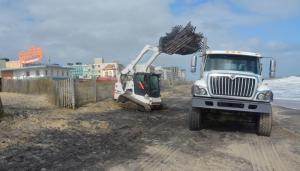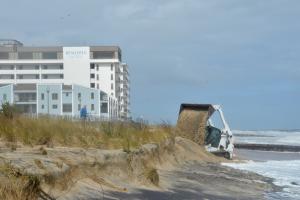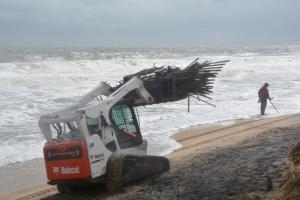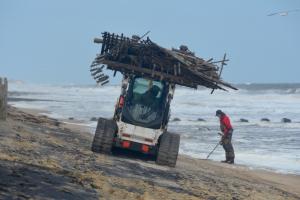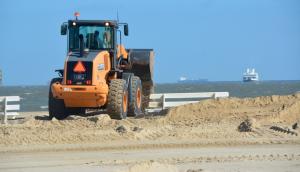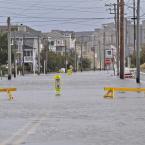Weekend coastal storm leaves behind damaged beaches
The sun may be shining, but cleanup is just getting started on Delaware beaches.
Last week's nor'easter-like storm produced high winds, strong waves and unusually high tides, resulting in flooding, beach erosion and debris throughout the Cape Region.
“We've lost sand almost everywhere,” said Tony Pratt, administrator of the Department of Natural Resources and Environmental Control's Shoreline and Waterway Management section. “We look at the dune as a sacrificial element. We've sacrificed the dunes, but we've spared infrastructure across the state by having good dunes in place.”
While there was little to no erosion to Dewey Beach dunes, he said, Rehoboth Beach suffered some scarping, which is when waves carve a cliff in the dune, with drop-offs in some areas.
What is that black sand?
When coastal storms hit the shore and churn the sandy faces, a black, sticky sediment makes its way to the beach surface.
Shoreline and Waterway Management Administrator Tony Pratt said that black sand is actually a composite of minerals that normally are weighted down below quartz, which gives the beige color and normal feel of Delaware beaches.
“All of our sand along the coast, even the stuff we pump, is washed out from the Appalachians over millions of years,” Pratt said. “The dominant mineral is quartz, but mixed in in small amounts are a series of other minerals.”
The quartz is readily movable, and in storm events is often stripped off the top of the beach, leaving the heavier, darker minerals on the surface. Pratt compared it to a gold miner panning for gold: The heavy gold flakes, in this case darker-colored minerals, are left behind as lighter sediment, which would be quartz on beaches, is easily washed away.
Rehoboth also had some intermittent power outages due to wind and rain on Rehoboth Avenue and at the city's wastewater treatment plant Oct. 3. City Manager Sharon Lynn said it's unclear how much sand has been lost and that there has been no timetable for replenishment. Lynn said she expects an estimate later this week and coordination with the Army Corps of Engineers for replenishment plans in coming weeks.
Pratt said the state's multiphase clean-up efforts will begin with dune fencing, which has been blown down or washed away at most of the state's ocean beaches. The fences are like tumbleweed piles, he said, collecting in bundles from 2 to 10 feet high in some areas.
“Cleaning up is a high priority,” he said. “It's a big priority to get the beaches safe.”
Work may be more challenging at Bethany and South Bethany beaches, where the storm has left 8- to 10-foot drop-offs along the beach, he said.
Pratt said surveys of bay beaches are underway, but reports have indicated that bay-front communities fared well in the storm.
Pratt said beach access points also must be repaired, and the dune line must be shored up, especially in Bethany and South Bethany where the damage was most severe.
With higher-than-average tides and persistent strong winds expected for the next few days, Pratt said minor damage to the beaches may still occur and will make cleanup efforts difficult as high tide continues to reach the dune line.
“We're really not completely out of the event,” he said. “Probably by Thursday we should see the ocean sorting itself out.”
While this weekend's storm brought to mind Superstorm Sandy in 2012, Pratt said the damage does not compare.
“Sandy was far worse than this,” he said.
Riverfront communities drenched by rain, high tides
Inland communities felt the brunt of the storm as local waterways expanded and flooded roads, towns and even some buildings.
In Milton, Front Street as well as portions of Magnolia and Chandler streets were still closed the afternoon of Oct. 5. Throughout the weekend, Milton Memorial Park and a public parking lot on Magnolia Street were completely inundated.
While the Milton Public Library on Union Street reported not one drop of river water leeching into the building, more low-lying businesses did not fare so well.
Pallets full of sandbags were dropped off at local businesses at the beginning of the storm, said P.C. Rods owner Patrick Conroy, and it was a constant battle against wind and tides throughout the weekend.
A handful of businesses were flooded during the storm, he said, estimating that peak flooding brought about 4.5 inches to his business at 113 Union St., as well as his wife's gift shop, Wine Knot Shop, next door, and a vacant storefront.
“A lot of the water has receded,” he said Oct. 5. “We saw the bottom of the bridge for the first time in four days.”
A meteorological mishmash
As rain began pounding the Cape Region, state and local officials went into storm mode. Gov. Jack Markell issued a limited state of emergency for Sussex County Oct. 2 through 1 p.m., Oct. 5, and several events – including the University of Delaware's Coast Day, Dewey Goes Pink and Boast the Coast – were cancelled in anticipation of the coastal storm and possible landfall of Hurricane Joaquin.
As the weekend progressed, hurricane forecasts showed Joaquin on a much more easterly track than originally anticipated, but a combination of meteorological events brought heavy winds with sustained speeds of 20 to 30 miles an hour and gusts more than 50 miles an hour. More than 4 inches of rainfall and abnormally high tides threatened waterfront communities.
Throughout the weekend, Route 1 between Dewey and Bethany was intermittently closed due to flooding. Dozens of other Sussex County roads were partially inundated.
As of noon Oct. 5, the Delaware Department of Transportation reported the following Sussex County road closures: Prime Hook Road in Milton, Fred Hudson Road between Route 1 and Cedar Neck Road, Front Street in Milton, River Road in Oak Orchard, Route 36 at the drawbridge to Bay Avenue and Round Pole Bridge Road between Hudson Road and the bridge. DelDOT reported another half dozen Sussex County roads still experiencing flooding that were not fully closed to motorists.
This week's forecast shows the Delmarva region drying out with sunny conditions expected through Thursday, according to Accuweather's forecast.
Ryan Mavity contributed to this story.
















